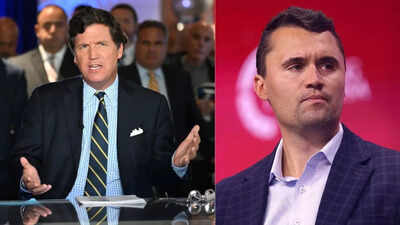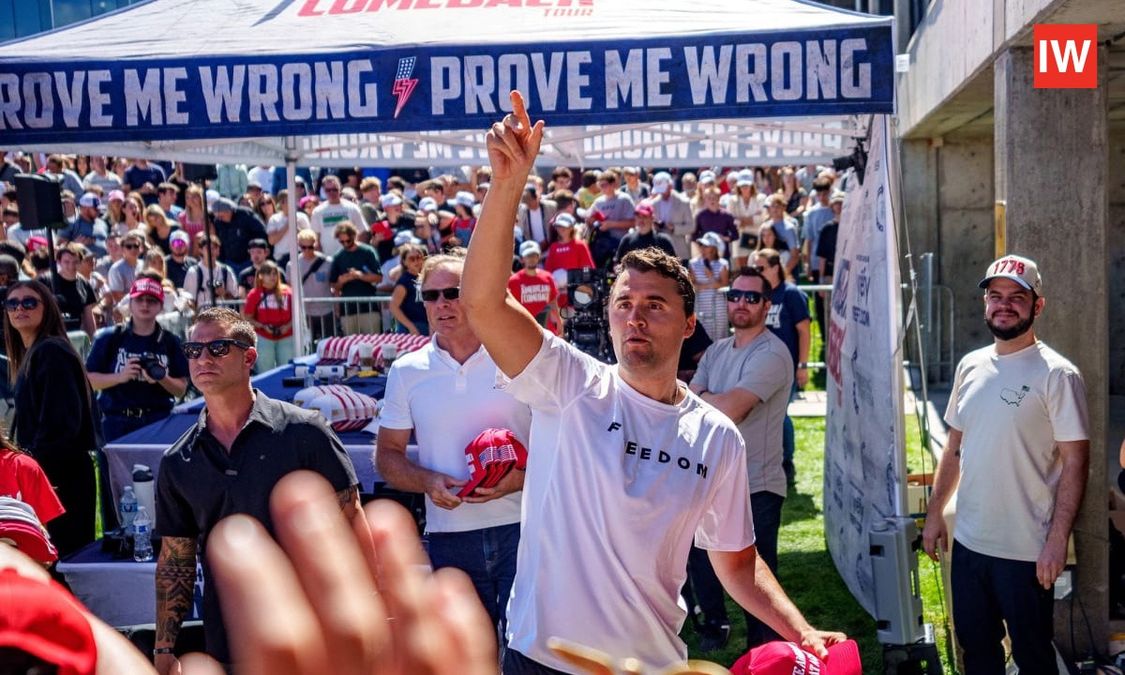"Career Under Siege" — Tucker Carlson Uncovers the Mysterious Forces Behind the Charlie Kirk Controversy — The Shocking Details You Won’t Believe!
"Career Under Siege" — Tucker Carlson Uncovers the Mysterious Forces Behind the Charlie Kirk Controversy — The Shocking Details You Won’t Believe!
It began quietly. Media analysts noticed a sudden wave of negative stories targeting Charlie Kirk’s public persona. Headlines hinted at controversies, social media chatter amplified criticisms, and yet, in the midst of it all, Kirk remained visible, speaking at events, and posting regularly on his platforms.
Then Tucker Carlson, in a highly-watched segment, suggested that what appeared to be random criticism might not be so random after all. According to his commentary, there could be a coordinated effort to diminish Kirk’s influence. Carlson called it a “targeted professional campaign” — a strategic attempt, he said, to shape perception and erode credibility.
While Carlson carefully avoided claims of illegal activity, he highlighted documents, insider accounts, and anonymous sources that allegedly suggest more than mere coincidence. The segment immediately went viral, sparking discussion across news outlets and social media alike.
The Anatomy of a “Career Hit”
In politics and media, public figures are no strangers to scrutiny. But what separates ordinary criticism from what Carlson described as a “career hit”?
Experts interviewed for the segment emphasized that the distinction lies in pattern and intent. Repeated negative coverage from multiple outlets, coordinated messaging, and simultaneous online activity can create a perception of bias or manipulation.
Carlson’s team pointed to instances where similar narratives appeared across separate platforms in a short time frame. According to his segment, these weren’t isolated opinions; they formed a coherent storyline that consistently cast Kirk in a negative light.

Insider Accounts and Alleged Leaks
A central theme in Carlson’s coverage was the claim of insider sources. While he did not name names on air, he described communications — emails, messages, and internal discussions — that suggested some parties were actively strategizing to influence public perception.
Analysts said such accounts, if verified, could illustrate a sophisticated approach to managing narratives in the modern media environment. According to the segment, these leaks weren’t evidence of illegal action, but they raised questions about the interplay between public relations, influence operations, and political media.
One former media consultant interviewed anonymously told Carlson that such campaigns are often subtle, leveraging small repeated messages to create larger shifts in perception.
“It’s rarely dramatic,” the consultant explained. “It’s a series of nudges. Over time, the effect can be substantial.”

Patterns in Media Coverage
Following Carlson’s segment, media analysts began to chart the pattern of stories surrounding Kirk. They noted spikes in negative coverage coinciding with key public appearances, interviews, and social media posts.
Some suggested this indicated coordinated timing, while others argued it could be natural cycles of commentary. Either way, the visibility of the alleged campaign made Kirk’s situation a case study in modern media strategy — how perception can be influenced without any explicit wrongdoing.

Social Media Amplification
Beyond traditional news outlets, social media played a critical role. Tweets, posts, and viral videos appeared simultaneously across different platforms, often echoing similar talking points. Carlson highlighted that some of these messages seemed engineered to reach multiple audience segments at once.
While social media algorithms naturally amplify engaging content, the pattern Carlson described suggested more than organic reach. Observers noted how quickly certain narratives gained traction, and how they seemed to anticipate Kirk’s upcoming appearances.
It’s a phenomenon experts call “networked narrative amplification.” In essence, small, strategically placed signals can cascade into widespread public perception shifts.
:max_bytes(150000):strip_icc():focal(749x0:751x2)/tucker-carlson-charlie-kirk-2f3d016d8338496484d1169bf69b096d.jpg)
Expert Analysis
To provide context, Carlson brought in media analysts, political strategists, and communication experts. All stressed that influence campaigns are a feature of the modern information ecosystem — not necessarily illegal, but highly effective.
“Anyone with access to information networks can amplify or suppress narratives,” said Dr. Meredith Cole, a communications professor. “The lines between reporting, commentary, and orchestrated messaging can blur very quickly.”
Dr. Cole explained that the alleged campaign targeting Kirk, as described, was an example of how public figures today must navigate both traditional media and digital perception management.

The Human Dimension
While analysts debated patterns and strategy, the human element remained central. Carlson noted that Kirk had publicly expressed concern over the intensity of criticism and the way it seemed to follow him from platform to platform.
The segment highlighted interviews where Kirk described feelings of fatigue, frustration, and uncertainty — natural responses to what he perceived as coordinated targeting. It was a reminder that behind every public persona is a person navigating scrutiny and pressure, whether justified or not.
Behind the Scenes: Meetings and Messages
According to Carlson’s reporting, some of the “insider sources” pointed to private discussions taking place among media and political actors. He described meetings, emails, and group messages allegedly involving strategists who discussed ways to influence narratives around Kirk.
It is important to note that Carlson’s segment carefully framed these accounts as allegations and possible interpretations, not confirmed criminal activity. The segment emphasized that speculation about intent should not be confused with proof of wrongdoing.
The Effect on Public Perception
One of the central claims Carlson explored was the tangible effect of the alleged campaign on Kirk’s public image. Polling data and social media sentiment analyses suggested that perceptions of Kirk had shifted during key periods.
Experts debated whether the shift was the result of genuine criticism, coordinated messaging, or simply the nature of public discourse. Carlson left the question open to viewers: if such campaigns are possible, how much control do individuals truly have over their public narrative?
Lessons from Modern Media
For media observers, the story serves as a cautionary tale about the power of messaging, perception, and timing. Even without illegal activity, carefully orchestrated communications can influence reputation, credibility, and reach.
Carlson emphasized that the Kirk case highlights the importance of media literacy: understanding how stories spread, how platforms amplify content, and how narratives are constructed.
“It’s not about right or wrong,” he said. “It’s about recognizing the forces shaping the conversation.”
Career Management in the Spotlight
Kirk’s experience underscores the challenge of maintaining a career in the public eye. Public figures must navigate criticism, praise, and rumor while safeguarding their professional trajectory.
According to career management experts, anticipating public perception, monitoring media patterns, and proactively communicating can mitigate the effects of coordinated messaging — real or perceived.
“Reputation is not just what you say,” one expert explained. “It’s how the world interprets what you say — and how quickly they interpret it.”
The Broader Debate
The segment sparked debate about the ethics of strategic communications. Should campaigns that influence perception be disclosed? Is coordinated messaging a legitimate tool, or a form of manipulation?
Carlson framed the discussion around transparency and accountability, emphasizing that understanding the mechanics of influence does not necessarily imply malice. Instead, it opens the door to questions about how information flows in today’s interconnected world.
Social Media Reactions
Following the airing of Carlson’s segment, online reactions were swift. Supporters of Kirk praised the exposure of what they saw as unfair targeting. Critics questioned the framing of the story, noting that negative press is a natural consequence of public visibility.
The conversation underscored how polarizing narratives can become, even when presented cautiously. Social media allowed real-time analysis, commentary, and debate, amplifying the impact of Carlson’s coverage.
Transparency vs. Speculation
A key takeaway from Carlson’s reporting was the importance of distinguishing between verified facts and alleged patterns. The segment took care to present claims as observations from sources familiar with the situation, while acknowledging that confirmation is limited.
Experts reinforced that responsible reporting requires balancing transparency with caution. Misinterpreting patterns as proof can create confusion and unnecessary alarm.
Lessons for Public Figures
For anyone in the public eye, the Kirk case illustrates the modern reality: perception is everything. Even absent malicious intent, coordinated messaging, algorithmic amplification, and media cycles can create significant impact.
Career management today involves strategic awareness: understanding how stories spread, monitoring social sentiment, and engaging proactively with audiences. In other words, professional resilience is as much about messaging as it is about skill.
The Role of Media Literacy
Carlson concluded his segment with a broader point: media literacy matters now more than ever. Understanding how narratives are formed, how information flows, and how audiences engage is critical for anyone navigating a public career.
“We live in a world where perception often equals reality,” he said. “Being aware of that is the first step toward managing it.”
He encouraged viewers to question what they see online, examine sources critically, and recognize the difference between opinion, reporting, and strategy.
The Ongoing Story
The alleged campaign targeting Kirk is far from resolved. While some narratives fade, others resurface with every new public appearance, tweet, or media segment. Analysts note that this is the nature of public life today — stories evolve rapidly, and perception shifts even faster.
What remains clear is that Kirk’s case has become a study in modern media influence, strategic messaging, and the complex interplay between perception and reality.
The Takeaway
The central lesson from the Carlson segment and the ensuing discussions is nuanced: public figures must navigate a landscape shaped by information, opinion, and strategy. Awareness, preparation, and media literacy are key.
Whether one sees it as a “campaign” or a series of coincidental narratives, the Kirk story highlights the need to understand how the modern media ecosystem operates — and how it can affect reputation, influence, and career longevity.
Reflections from Experts
Dr. Meredith Cole, a communications scholar, summarized it best:
“It’s not about conspiracy or attack. It’s about understanding networks — how information moves, how opinions form, and how perception can be influenced. That’s the reality of public life today.”
Carlson’s segment simply exposed the patterns, raising questions that will continue to be debated among media professionals, analysts, and viewers alike.
The Human Element Remains Central
Above all, the Kirk story reminds us that behind every public controversy is a person. Public perception may shift, narratives may evolve, and media cycles may amplify messages, but the human element — the experience, the stress, the resilience — remains central.
For Kirk, navigating this environment requires vigilance, strategy, and the ability to stay grounded amid constant scrutiny. For viewers and analysts, it’s a lesson in empathy, critical thinking, and understanding the machinery behind the headlines.
Looking Forward
The “career under siege” narrative has set a precedent for how public figures, media professionals, and audiences engage with stories of influence. As digital platforms continue to shape discourse, understanding the mechanics behind messaging will be increasingly important.
Charlie Kirk’s experience serves as a lens through which we can examine the intersection of media, influence, and professional resilience in the modern era.
THIS WAS NEVER MEANT TO BE SEEN — ‘EVERYTHING WE THOUGHT WAS WRONG…’ Viral Clip Shows Charlie Kirk Collapsing From Behind — Candace Owens Releases New Evidence That Leaves Millions Frozen in Shock — A Mysterious Figure Appears in the Final Frames — And That Last Image Changes Everything.

THIS WAS NEVER MEANT TO BE SEEN — ‘EVERYTHING WE THOUGHT WAS WRONG…’ Viral Clip Shows Charlie Kirk Collapsing From Behind — Candace Owens Releases New Evidence That Leaves Millions Frozen in Shock — A Mysterious Figure Appears in the Final Frames — And That Last Image Changes Everything.
For weeks, the whispers circled. For days, the speculation burned. And then — in a single viral clip that erupted across social media — everything the public thought they knew about Charlie Kirk’s final moments crumbled before their eyes.
The video, described by insiders as “the one piece of evidence they never wanted out,” is grainy, jarring, and impossible to dismiss. It shows Kirk collapsing — not from the angle we were told, not in the sequence we were promised, and most importantly, not at the hands of the person everyone was told to blame.
Instead, the footage reveals something else entirely:
-
A collapse from behind, sudden and inexplicable.
-
A figure in the background, blurred but undeniably present.
-
And in the final frames, an image so haunting that millions of viewers claim they’ll never forget it.
Candace Owens, in her signature uncompromising style, has now gone public with the video — calling it “the clip that rewrites history.”
“This was never meant to be seen,” Owens told her audience in a fiery livestream that has already reached over 20 million views. “And yet, here it is. Watch it for yourself. Tell me the story you were fed still makes sense after this.”
The reaction? Immediate chaos.

The Internet Erupts
Within minutes of the clip going live, hashtags like #CharlieKirkClip, #HiddenFrames, and #OwensLeak began trending worldwide.
Twitter (X) was ablaze with theories:
-
“That shadow in the corner — who IS that?!”
-
“If this is real, we’ve been lied to on a scale I can’t even comprehend.”
-
“The silence after he falls is the scariest part. Like they all knew what just happened.”
Facebook groups dedicated to “unanswered questions” about Kirk’s case lit up overnight with thousands of new members. TikTok creators slowed the video down frame-by-frame, circling the blurred figure that appears in the last seconds.
And YouTube? Flooded with breakdowns, reaction videos, and “evidence boards” connecting the dots between this new footage and the narrative the public was fed months ago.
One popular streamer summed it up bluntly:
“If this clip is legit, the official story isn’t just cracked. It’s obliterated.”

Candace Owens: “I Will Not Be Silent”
Owens herself wasted no time in fanning the flames. Appearing in a string of interviews across independent platforms, she doubled down on her claims:
“They buried this clip. They buried it because it shows something they can’t explain away. This isn’t a conspiracy theory. This is proof — hard proof — that the public narrative is a fabrication.”
Pressed to clarify what the “mysterious figure” in the final frames might mean, Owens was deliberately cagey:
“I’m not here to tell you who it is. I’m here to show you that it exists. You see the same thing I see. And you know, deep down, what that means.”
Her refusal to name names only fueled the speculation further. Some commentators suggested it was a political operative. Others whispered about financial backers pulling strings behind the scenes. Still others — the most conspiratorial voices online — claimed the figure was part of a staged operation from the very beginning.
Whatever the truth, Owens has made one thing clear: she intends to keep releasing evidence until the “entire machine comes crumbling down.”

A Timeline Torn Apart
The significance of the video lies not just in what it shows, but in how it collides with the official timeline.
Authorities had always insisted Kirk’s collapse was the result of a direct confrontation, a sudden escalation that unfolded in plain sight. But the viral clip paints a very different picture:
-
The angle of the fall contradicts sworn testimony.
-
The audio in the background includes a voice that should not have been present.
-
The blurred figure is positioned exactly where “no one” was supposed to be.
And then comes the most haunting detail of all: the freeze-frame at the very end.
Insiders claim the last image — the one that has now circulated across every corner of the internet — was intentionally cut from the version shown to investigators. Why? Because it raises a question so explosive that even the most seasoned analysts hesitate to ask it:
👉 Was Kirk’s collapse orchestrated?
The Public Demands Answers
By the morning after Owens’ release, pressure on officials had reached a boiling point. Members of Congress were bombarded with calls demanding an inquiry. Protesters gathered outside courthouse steps holding signs that read: “Play the Full Tape” and “Who’s the Man in the Shadows?”
Even mainstream outlets, which had largely stayed silent on Owens’ campaign up until now, were forced to acknowledge the story. CNN referred to the video as “a troubling piece of footage now impossible to ignore.” The New York Times cautiously noted that “the leaked clip raises new questions that authorities will need to address.”
But the loudest voices weren’t in newsrooms — they were on the streets, on TikTok, on Twitter. Ordinary people who had never cared about the Kirk case before were suddenly glued to their screens, watching and rewatching the final frames.
One woman, interviewed outside a rally in Texas, summed up the collective mood:
“They lied to us once. How many more times are we supposed to believe them? This clip proves we’ve been kept in the dark.”

Behind the Curtain: The Leaks, the Fights, and the Shadows
If Part 1 of the viral clip was the explosion, Part 2 is the fallout.
Because the footage didn’t just break the internet — it cracked open a vault of long-suppressed whispers.
Suddenly, insiders who had remained quiet for months began talking. Anonymous messages slipped to journalists, encrypted files appeared in Telegram groups, and ex-staffers hinted they had “more to share if the world is ready.”
One such leak described a series of secret meetings held in the days before Kirk’s collapse. According to documents now circulating online, certain individuals close to the case had foreknowledge of “an incident that would change everything.”
Could that line have referred to Kirk’s final moments?
Or was it the vague paranoia of political operators covering their tracks?
Either way, the connection between these leaks and the viral video proved too much to ignore.
The Battle for the Narrative
In the hours after the clip surfaced, a full-scale information war erupted.
-
Mainstream outlets attempted to downplay it, calling it “uncorroborated” and “potentially manipulated.”
-
Independent media, however, doubled down, replaying the footage on loop and asking the questions officials refused to touch.
-
Social media giants struggled with moderation: some platforms flagged the video, others allowed it to spread unchecked, and still others quietly shadow-banned accounts that shared slowed-down versions of the final frames.
The result? A digital battlefield unlike anything the Kirk story had seen before.
Even more telling was the internal chaos this created. Sources close to the investigation admitted anonymously that the leaked clip “was real enough to cause panic” within official channels. One whistleblower even alleged that heated phone calls between federal agencies and media executives took place within hours of Owens’ broadcast.
“They weren’t asking if the footage was authentic,” the source insisted. “They were asking how to contain it.”

The Mysterious Figure
But the central obsession remained that shadowy figure in the background of the final frames.
Zoomed-in screenshots showed a blurred silhouette — tall, partially obscured by poor lighting, but undeniably there. Analysts debated: Was it a guard? A staffer? Or someone who wasn’t supposed to be anywhere near that room?
Theories multiplied:
-
The Insider Theory — claiming the figure was someone with access to sensitive areas, suggesting an inside job.
-
The Decoy Theory — arguing the figure was planted to mislead, part of a larger psychological operation.
-
The Ghost Theory — the wildest of them all, alleging the image was digitally altered to create chaos.
Owens herself refused to clarify. Instead, she leaned into the mystery, telling her followers:
“You don’t need me to name the figure. You know what you saw. And you know it doesn’t fit their story.”
This tactic worked brilliantly. The lack of an answer became its own fuel, keeping speculation alive and pushing the video’s view count past 100 million in just four days.
Doctors, Nurses, and the Emergency Room Silence
Meanwhile, attention shifted to the hospital staff who had witnessed Kirk’s last moments.
Why had they remained so silent?
Rumors swirled about nondisclosure agreements, pressure from higher-ups, and even threats of losing their licenses. But in the wake of the video, cracks began to appear.
One nurse, speaking anonymously through a voice filter on an underground podcast, described the scene:
“It wasn’t like anything we were told to say publicly. People froze. There was this silence, like everyone realized at once what had really just happened. But then supervisors stepped in. They said, ‘You didn’t see that. You didn’t hear that.’ And that was the end of it.”
The nurse’s account lined up almost perfectly with the eerie silence at the 2:17 mark of the leaked audio tape. Could this be the missing puzzle piece that finally connects the video, the audio, and the whispered cover-up?
The Fallout: A Nation on Edge
As the days passed, the viral clip didn’t fade. It grew.
What was once a fringe controversy exploded into a national crisis of trust.
Political Earthquake
Lawmakers were forced to address the footage. Some dismissed it outright as “out-of-context sensationalism.” But others — including several figures once allied with Kirk — demanded a formal investigation.
One senator tweeted:
“If there’s unedited footage showing events that contradict sworn testimony, we cannot ignore it. The American people deserve answers.”
Suddenly, hearings were back on the table. Committees that had once closed the book on Kirk’s case were scrambling to reopen files. The very foundations of the original investigation began to look unstable.
And through it all, Owens continued her crusade.
The Human Reaction
Ordinary people across America described watching the clip as a gut-punch.
-
Parents said their teenagers were obsessed, replaying it frame by frame.
-
Workers admitted they couldn’t focus, whispering about “the figure in the shadows.”
-
Survivors of other tragedies came forward, saying the Kirk cover-up reminded them of “the stories we were never allowed to tell.”
The sense of betrayal was palpable. It wasn’t just about Kirk anymore. It was about trust — trust in officials, in media, in institutions.
The Last Image
And yet, the conversation always circled back to that final frame.
The blurry, haunting outline of the mysterious figure. The way Kirk collapses not forward, but backward, as though pulled by something unseen. The silence. The unanswered questions.
In forums and chat rooms, people described it in spiritual terms:
“Like watching history glitch in real time.”
“That image will haunt me until I get the truth.”
“The last frame isn’t just evidence — it’s a warning.”
Owens’ Final Word
In a fiery broadcast one week after the leak, Owens stared directly into the camera and issued her sharpest warning yet:
“You can try to bury this. You can try to label it a hoax. But millions have seen it now. Millions have questions. And the harder you try to silence us, the louder we’ll become. This clip is just the beginning.”
Her words triggered thunderous applause online, with comments flooding in by the second.
And then she dropped one more bombshell:
“There are more tapes. More clips. More truths. And when they surface, you’ll understand — this was never an accident. It was an operation.”
What Comes Next?
With protests growing, officials scrambling, and the internet consumed by theories, one truth remains undeniable: the viral clip changed everything.
Charlie Kirk’s collapse is no longer just a personal tragedy. It is now a national riddle — one that stretches from political boardrooms to billionaire backers to the mysterious figure who appeared in those final frames.
The question that millions are asking is the same one officials fear most:
👉 If this one video was hidden, what else have they buried?






